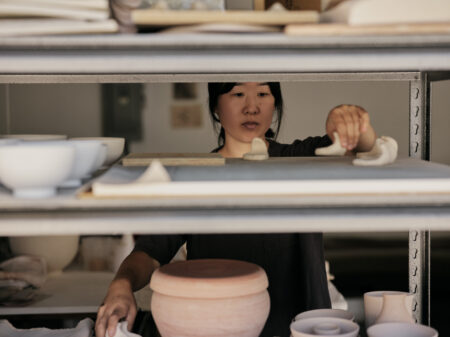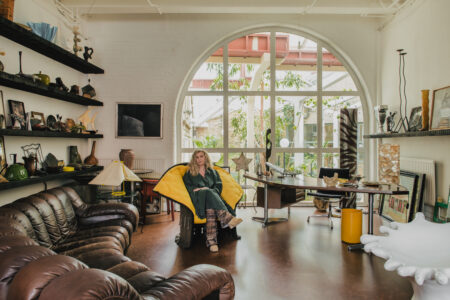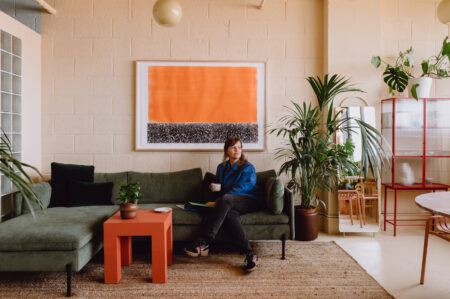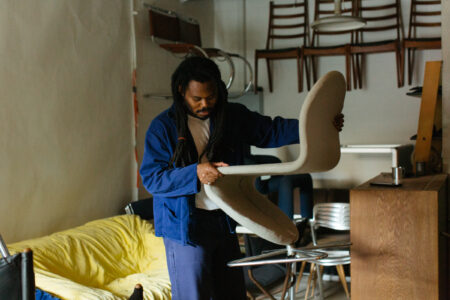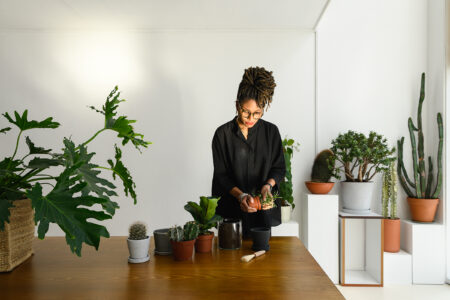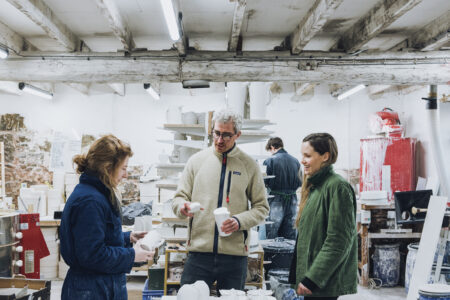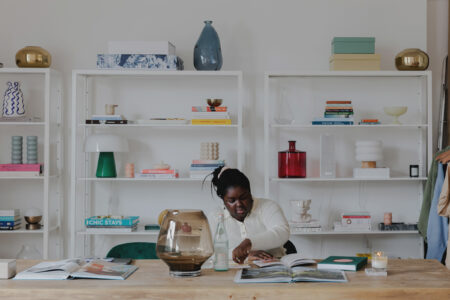Value Added: how five households transformed their outdoor space into home studios

Home studios, cabins, garden rooms – call them what you want, use them how you like and design them as you wish. Ahead of the launch of the latest edition of The Modern House Magazine this spring, we’re sharing a shortened version of our story from Issue No.3, in which we discover why having flexible, non-perspective space separate from but near home is a gift that one keeps on opening up.
Annabelle and Stephen Harty’s Dodsdown Studio in Wilton, Wiltshire
Stephen: “We’d been to Denmark on a trip to see our daughter, Olive, who was studying ceramics on the island of Bornholm. We saw lots of timber buildings there and based our design on them. It blurs the lines between an office, a project space and a studio for our practice, Harty & Harty. I would really encourage people to do something like this if they can. If you can go single storey outwards, it then gives you space you can do lots of stuff with.”
Annabelle: “Friends now come and stay and get on with writing in here, which we like. Also, one of the reasons for building it was that we’re a family of four, my brother’s is a family of five, and we do get together a lot. It’s squished in the house with that many so this has meant that we could all be here together, and eat together without sitting on each other’s knees. So we have more parties. It’s great for dancing.”
Steve Barron’s Polyvalent Studio at Margent Farm, Cambridgeshire
“The studio was an unexpected by-product of the house that architect Paloma Gormley built on my farm in Cambridgeshire. I’ve recently been exploring alternative, low-impact materials that can be used for construction. With Paloma’s team, we developed these prefabricated panels made with the hemp grown on the farm. As we were finishing the house, Paloma asked if she could use material left over from the main build for a project that could be designed and built by her students.
“I knew we would love a little outbuilding that could give us room to practise yoga away from the house, so I said yes. There’s a particularly special atmosphere inside. It feels healthy to spend time in and the quality of the sound is amazing – it’s so still and quiet, like a recording studio. There’s something seductive about locking out the noise of the outside world. When the studio was built it was situated away from the house in an empty field. Now it’s surrounded by the hemp plants that you can see blowing in the breeze from the windows. It’s almost like being at sea.”
Luis Grilo and Zoë Marden’s Garden Pavillion in Hackney, east London
Zoë: “For a long time I had wanted to create a space at home that encouraged an encounter with art. I began to imagine this as somewhere for working and making, where I could invite people to share their work. Conceptually we were thinking about how to create something that was in harmony with its environment. Connecting with nature was definitely at the forefront of our minds when thinking about this space. Being in the garden shifts your perspective and I’ve seen it have an impact on my work as an artist and curator.”
Luis: “We really didn’t want to just drop a building within the footprint of the garden. Instead, we tried to create a composition where the studio merged with those elements that were already there – the fence blending with the larch cladding, for example. We really wanted to embrace the textures and ageing process of these natural materials – how they will look in a year or in 10 years’ time will be in parallel to the way the garden itself will grow and transform.”
Scott Schwager’s Nettle Studio in Golders Green, north London
“I was used to commuting for an hour or two across London to get to my studio. Now I get to work from home but because it’s in the back garden there are no distractions. It’s a quiet and relaxing space that feels like an extension of the garden. You can hear squirrels and birds, and the trees rub against the studio.
“My work is divided between studio-based practice – drawing, writing and painting – and Walk&Talks, artworks that are based around walks I lead through urban environments. This space has really brought all of that together. It’s a relatively small studio but it’s very generous in terms of the flexibility it offers – there’s a place for the computer, a place to draw, a place to paint. There’s really the freedom to think and let an idea evolve here. And once I start on something here, I can lose all sense of time.”
Tim Robinson and Emma Foreman’s Terrazzo Studio in Dalston, east London
Tim: “We wanted to create a tropical haven. There’s inspiration from Mayan architecture and we did a lot of landscaping planning when we were in Mexico. We were sat on the beach in Tulum thinking, ‘This is the feel we want.’ We have the white concrete with the gravel, the sculptural forms and the simple geometry. We mixed that concept with references from Italian architecture – that’s where the terrazzo came in. It is completely bespoke – and we did it all in the garden.”
Emma: “We didn’t start off intending to make the studio all on our own but, financially, it made sense. And we really enjoyed it. YouTube can teach you a lot! I was worried we wouldn’t use the space but we’re here all the time. I love how relaxing it is. I’ll do my morning workout here, we work here, we have a projector and do cinema nights, we cook dinner in the house and then bring it down. In the winter, we have the fire pit out and we’ve got underfloor heating in here, so it’s really cosy.”




















